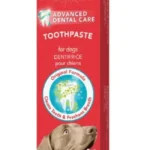I’ve always found it interesting how dogs squeeze so much life into a short span of years. The life cycle of a dog is a fascinating transformation. From a young adorable pup that bites your shoes to a senior companion.
Throughout their life cycle, your dog’s needs, behaviors and health concerns change. It helps to know what your dog experiences at every stage so you offer them better love, care, and nutrition. Here is how to handle each stage, the common health issues at different stages and their nutritional needs.
The 4 Stages of a Dog’s Life Cycle
The life cycle a dog is divided into four:
- Puppyhood
- Adolescence
- Adulthood
- Senior years
A dog’s age, breed, size, and genetics determine how quickly they move through each phase. Can a dog live 20 years? Yes, some breeds can, though it’s uncommon. Smaller breeds like Chihuahuas enter adulthood later and live longer, sometimes up to 20 years. Larger breeds, like Great Danes, age faster and may only live up to 7-10 years. Let’s take a closer look into the four life cycles of a dog.
1. Puppyhood (Birth to 6-12 Months)
At this first stage, the puppy is full of energy and curiosity which manifests as chaos. Puppies are like toddlers, eagerly exploring their world. How you interact and what you expose them to at this stage lays the groundwork for their entire life.
How to Handle This Stage
- Socialization
Expose your puppy to as many new experiences as possible. Let them meet new people, animals, sounds and surfaces. Exposure reduces fear-based behaviors in adulthood.
- Start Basic Training
Teach your puppy commands like ‘sit’ and ‘stay’. This is the answer to the common how to stop a puppy from biting. Puppies bite to play and relieve teething discomfort. Redirect this behavior to chew toys to prevent damage to your shoes, couches and yourself in case the biting gets out of hand.
- Regular Vet Visits
Puppies need frequent checkups during their first year to ensure they’re growing well and adjusting to routine care.
Nutritional Needs
- Puppies grow fast. Thus, they need high-quality proteins and fats for muscle and brain development. Look for diets labeled “puppy formula” and enriched with DHA for cognitive development. In as much as they need proper nutrition, avoid overfeeding as obesity in puppyhood results in orthopedic issues later.
Common Health Issues
- Parasites
Worms-roundworms, hookworms are quite common. These are passed either from the mother or the environment. Therefore, routine deworming is important.
- Vaccination-Preventable Diseases
Puppies are at risk for parvovirus, distemper, and rabies. What vaccinations do puppies need? Your vet will recommend a series of core vaccines to protect against life-threatening illnesses.
2. Adolescence (6 Months to 2-3 Years)
This is the “teenage phase” in the life cycle a dog. It is marked by hormonal changes and a tendency to challenge authority. Like humans, adolescent dogs will test boundaries as they establish their place in the pack.
How to Handle This Stage
- Consistency
Adolescent dogs may conveniently ‘forget’ training as they test boundaries. You should be patient with them and reinforce training as well as boundaries. Your dog needs a trustworthy leader so they can remain consistent.
- Exercise
Their energy peaks during this stage. Plenty of physical exercise (walks, agility classes) paired with mental stimulation (puzzle toys, commands) prevents destructive behavior.
- Female Heat Cycles
How do I know if my dog is on her cycle? Female dogs experience their first heat around 6-12 months. Look for swollen vulva, bloody discharge and increased clinginess. How long is a dog’s cycle?
Heat cycles last approximately 21 days. You should also read this guide on dogs sexually attracted to humans to know how to handle any humping attempts from a male dog.
Nutritional Needs
- Adolescents require lean proteins for muscle growth and complex carbohydrates for sustained energy. Joint supplements like glucosamine are beneficial for larger breeds at this stage.
Common Health Issues
- Spaying/Neutering Concerns
Most pet parents prefer spaying, surgically removing their dog’s ovaries and uterus, or neutering, removing their testicles. They prefer it when their dog begins to exhibit behavioral changes such as roaming and marking. Before considering it, consult your vet to discuss the benefits and risks.
- Hip or Elbow Dysplasia
Larger breeds are particularly prone to these joint conditions. Obesity can cause dysplasia, therefore, avoid overfeeding and keep them active to prevent damage to growing bones. You should also get the best dog bed for hip dysplasia to ease their pain.
3. Adulthood (2-3 Years to 6-8 Years)
Welcome to your dog’s prime years! Adults are well-mannered, loyal companions. They don’t need the constant attention puppies require, although this doesn’t mean you can neglect them.
How to Handle This Stage
- Stay Active
Adult dogs still need daily exercise even though their energy levels are lower compared to adolescent pups. Take occasional walks and let them enjoy dog parks at least once a week.
- Routine Care
Vet checkup visits can detect early issues. Dental cleaning is especially important to avoid a fish like smell from their mouth and yeast infections as tartar buildup.
Nutritional Needs
- Adults need a maintenance diet high in antioxidants and omega-3s to promote immunity and coat health. Avoid excessive treats and human food!
Common Health Issues
- Obesity
Lack of exercise and overfeeding will lead to weight gain. Too much weight will put strain on joints and increase the risk of diabetes.
- Allergies
Dogs may develop food or environmental allergies. Symptoms include persistent itching or gastrointestinal issues. Consult your vet about hypoallergenic diets and treatments.
4. Senior Years (6-8 Years onward)
It’s the final stage of the life cycle a dog, where there is a big shift in their needs. Senior dogs slow down and require extra care to age gracefully and comfortably.
How to Handle This Stage
- Prioritize Comfort
Invest in orthopedic beds and anti-slip rugs for arthritic dogs. Short, gentle walks keep them mobile without overexertion.
- Veterinary Checkups
Schedule frequent vet visits to catch issues like kidney disease, diabetes, arthritis, or dental problems early. Ask your vet for guidance on euthanasia if needed.
Nutritional Needs
- Seniors need fewer calories to avoid weight gain. They benefit greatly from increased fiber for digestion and omega-3s for joint health. Prescription diets addressing kidney or liver function are sometimes needed.
Common Health Issues
- Cognitive Dysfunction
Much like Alzheimer’s in humans, dogs can experience confusion and restlessness. Provide mental stimulation with simple tasks and plenty of affection.
- Arthritis
Degeneration in joints can make movement painful. Supplements like glucosamine or prescription medications help manage pain effectively.
- Diabetes
Diabetes mellitus is common in senior dogs and most diagnoses happen for dogs between the age of 7 and 10. If you notice your senior dog drinking so much water, it could be an early sign of diabetes.
Can a Dog Grieve Itself to Death?
Dogs form deep bonds with their humans and other pets. Yes, dogs can grieve after losing a loved one. It’s not scientifically accurate to say a dog can grieve itself to death, sustained grief can weaken their immune system or lead to depression. Signs of grief include reduced appetite, lethargy and withdrawal. Respond with patience, extra affection and a consistent routine to help your dog recover.
Wrapping Up
The life cycle a dog comes with precious moments tied to every stage of their development. From the boundless energy of puppies to the calmness of seniors, each phase presents unique challenges, joys and opportunities to nurture your beloved dog. Proper nutrition, exercise and vet checkups remain important at each stage. Happy pet parenting!





